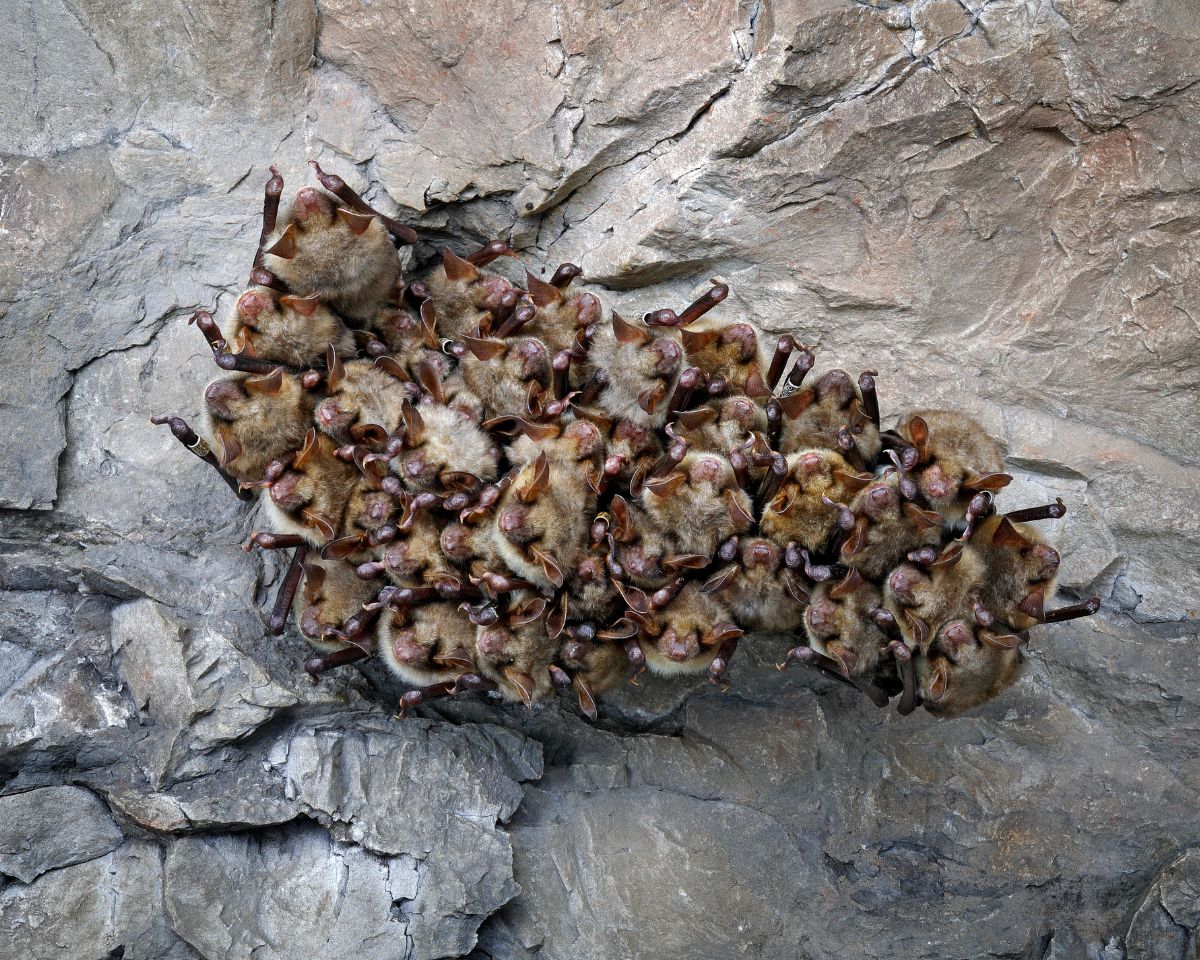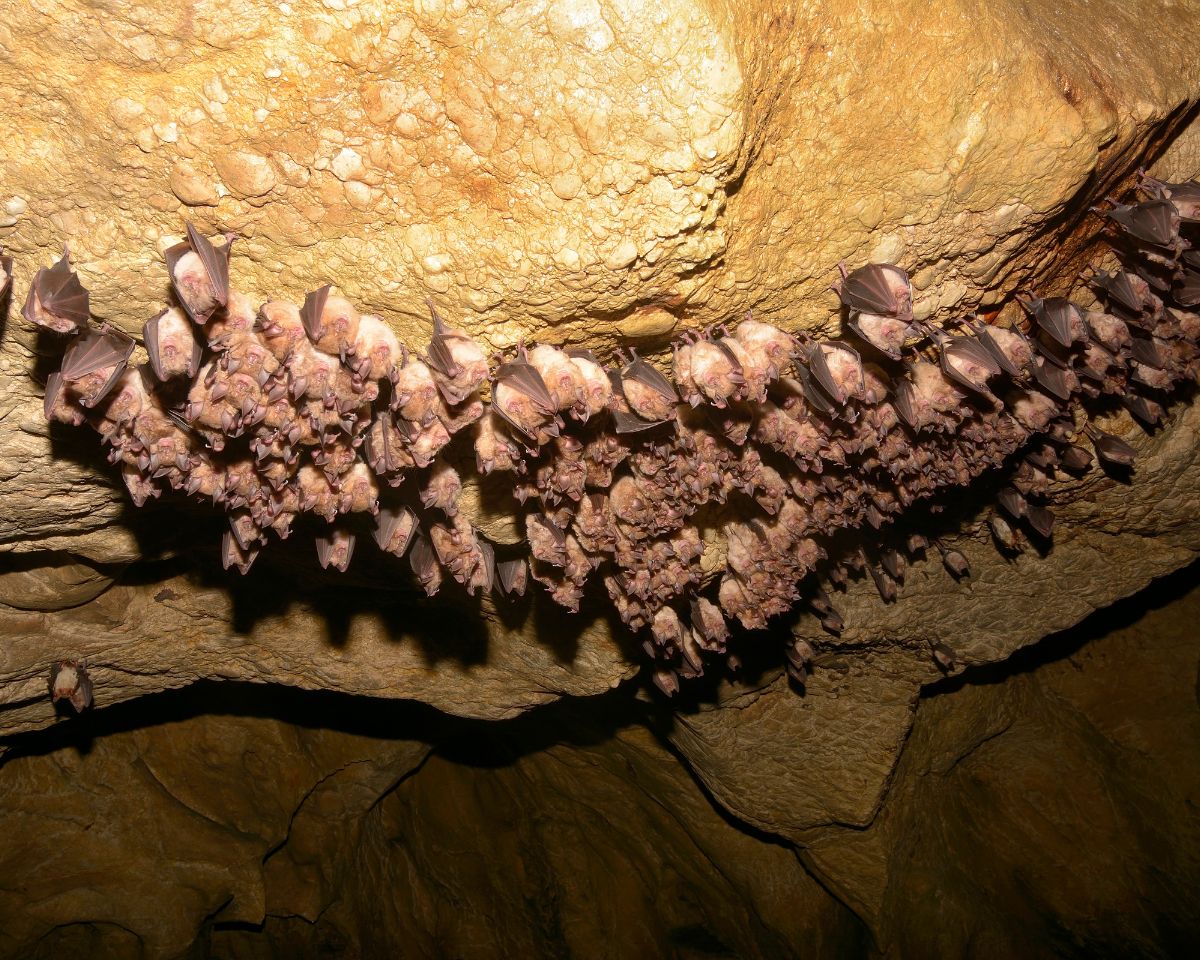Bat Hibernation
During bat hibernation, bats enter a state of torpor where their metabolism slows down and their body temperature drops to conserve energy. This allows them to survive the winter months when food is scarce and temperatures are low.
Bats survive winter by hibernating for three to six months, conserving energy and retaining warmth. They skillfully lower their body temperature and metabolic rate, entering a state of torpor. This allows them to align their temperature with their environment and conserve energy. Despite appearing dormant, they must occasionally awaken to regulate their temperature and find food.
Diverse hibernation patterns in bats, influenced by species, location, and environmental factors, are crucial for their winter survival. Comprehending these patterns, dictated by factors like species, habitat temperature, humidity, and energy expenditure, is essential for their conservation.
Bat Hibernation Habits
Amidst winter’s chill, bats employ a distinctive survival mechanism: a lengthy and intense sleep, termed hibernation, lasting anywhere from three to six months. This period of profound rest is a strategic adaptation to the severe season, facilitating energy conservation and warmth retention for the bats.
Throughout hibernation, bats skillfully modulate their body temperature and metabolic rate. The diminution of these vital physiological functions serves to conserve energy, thus enabling the bats to withstand winter’s harshness. Fascinatingly, bats have the exceptional capability to align their body temperature with that of their ambient environment.
Such adaptive flexibility instigates a state referred to as torpor, marked by a dramatic decrease in body temperature and near-complete inactivity. Despite their seeming dormancy, bats must intermittently regulate their body temperature. Consequently, they awaken at intervals, stirring or even braving the outdoor chill in pursuit of food if required.
Bat Hibernation Patterns

Hibernation patterns in bats manifest a rich tapestry of diversity, influenced by factors such as species variations and timing, with some commencing hibernation earlier or extending it longer than others.
For example, certain bat species might initiate their hibernation phase as prematurely as September, while others delay until November. Moreover, the hibernation duration also varies, with some bats cocooning themselves for mere weeks, while others hibernate for multiple months.
A thorough grasp of these hibernation patterns is paramount for the survival of bats during the frosty winter months. Several factors that intricately influence these patterns include:
The specific bat species Their geographical habitat The temperature and humidity levels at the hibernation site The energy expenditure associated with prolonged hibernationThrough a comprehensive understanding of the distinct hibernation patterns exhibited by various bat species, we are better equipped to safeguard these nocturnal creatures during winter, thereby ensuring their continued survival.
Bat Hibernation Locations
Our winged mammalian companions seek snug hibernation abodes during the winter months. Bats require a cool, stable environment to decelerate their metabolism and conserve energy. They often gravitate towards caves or abandoned mines, maintaining a steady 40-60 degrees Fahrenheit.
However, not all bats hibernate in such locations. Some find refuge in trees, beneath the bark, or in sheltered areas like buildings or bridges, offering protection from the elements and a cool enough atmosphere to induce torpor.
Regardless of the hibernaculum, it’s vital for bats to secure a safe, secluded spot for winter hibernation, ensuring their survival until the warmth of spring returns.
Bat Hibernation Cycles
With winter’s arrival, bats plunge into a cycle of torpor, a strategic adaptation to conserve energy and endure until spring’s advent. These winged mammals enter a hibernation phase during the frigid winter, characterized by a drop in body temperature and decelerated metabolism. This state facilitates energy conservation and reliance on their body fat reserves until the resurgence of warmer weather.
Hibernation cycles in bats exhibit remarkable variability, influenced by factors such as species type and geographical location. Certain bats may hibernate for mere weeks, whereas others may extend their hibernation to span several months. The hibernation duration is also contingent on food availability and the temperature of their chosen hibernaculum.
Extremely low temperatures may induce bats into deep hibernation, a potentially perilous state if their body fat reserves are inadequate for survival. Comprehending these hibernation cycles is essential for bat conservation efforts, as any disruptions during hibernation could cause them to awaken prematurely, depleting their energy reserves and potentially leading to their demise.
Bat Hibernation Preparation
In preparation for winter, bats initiate a process of metabolic downregulation and temperature reduction, a state that may span several months. The duration is contingent on factors such as food supply and ambient temperature, with certain species known to hibernate for up to half a year.
As a prelude to hibernation, bats engage in voracious feeding during the late summer and early autumn. This allows them to accumulate energy reserves in the form of body fat, which fuels them during their extended period of dormancy.
Once sufficient energy is stored, bats commence their search for a suitable hibernation site. They favor caves or similarly dark, sheltered areas that retain cool temperatures throughout the winter season.
During their hibernation phase, bats’ body temperature aligns with their environment, and their physiological functions, including heart rate and respiration, slow remarkably. This energy conservation strategy enables them to survive months of inactivity without the need for food or water.
Bat Hibernation Physiology

Curious about how bats endure the long, frosty winter months? They enter a state called torpor, characterized by decreased activity and lowered body temperature, allowing them to conserve energy. This hibernation also involves a reduction in metabolic rate, decreasing their need for food and oxygen. Some species can even survive months without food.
Bats awaken from torpor roughly every few weeks for hydration or waste excretion. Despite extended dormancy, they preserve muscle mass and bone density, thanks to hibernation-induced hormones.
In essence, bat hibernation demonstrates remarkable animal adaptation strategies for survival in harsh environments.
Bat Hibernation Adaptations
Bats exhibit remarkable adaptations to weather the biting winter months. A key survival strategy is their ability to decelerate metabolism, conserving energy during extended periods of inactivity. They also amass specialized fat reserves for sustenance when food becomes scarce, which is vital considering they may shed up to 30% of their body weight during hibernation.
In addition to these, bats display other survival adaptations. They hibernate in protected spaces like caves, offering shelter from harsh conditions. They can align their body temperature with their surroundings, reducing energy requirements. Interestingly, bats recycle their urine to prevent dehydration, capable of going several months without water intake.
These adaptations, including slowed metabolism, reliance on fat reserves, and secure shelter, exemplify bats’ adaptive prowess, enabling their survival in austere winter environments.
Bat Hibernation Benefits
Having explored the extraordinary adaptations bats employ for hibernation, let’s delve into the advantages of this process.
Hibernation enables bats to conserve energy and subsist on their fat reserves, crucial during winter when food is scarce. Their ability to decelerate metabolism and conserve energy surpasses many other animals, allowing them to endure extended fasting periods.
Beyond personal survival benefits, bats also render invaluable ecological services during hibernation. Numerous bat species are insectivorous, and by curbing insect populations within caves and other hibernation sites, they play a pivotal role in pest control and disease spread reduction.
This ecological contribution is especially significant in agricultural regions where insect pests pose substantial threats to crop health.
In essence, bat hibernation, though seemingly a lengthy and dormant process, imparts crucial benefits to both the bats themselves and the ecosystems they inhabit.
Bat Hibernation Challenges
The harsh winter months pose significant challenges for animals, necessitating unique adaptations for survival. Bats, notably, have devised a remarkable strategy: hibernation in caves. Yet, this survival mechanism is not without its trials.
Premature arousal presents one of the most formidable challenges for hibernating bats. Excessive activity during hibernation rapidly depletes their fat reserves, leading potentially to starvation and mortality.
Additionally, securing a suitable hibernation site presents another hurdle. Bats seek caves that are cool yet not excessively cold, and sufficiently humid to avert dehydration. However, as human encroachment persistently disrupts and destroys natural habitats, locating appropriate hibernation sites becomes increasingly difficult.
In light of these challenges, it becomes apparent that winter survival for bats is far from assured. Greater efforts are thus imperative to safeguard these ecologically significant creatures.
Bat Hibernation Impacts
The profound impact of winter on these captivating creatures unravels their indispensable role in ecosystem preservation and the potential ramifications of their dwindling numbers.
Bats, during winter, retreat into hibernation within caves or other secluded locations, conserving energy to withstand harsh conditions. This restful period allows them to preserve vital resources and diminish their metabolism, facilitating survival for months without food.
However, the disconcerting decline in bat populations carries implications that extend beyond losing a unique species. Here are three key impacts linked to bat hibernation:
Diminished bat populations equate to fewer pollinators, negatively affecting plant growth and reproduction. Given bats’ role as insect predators, their decline could lead to insect overpopulation, resulting in vegetation destruction and potential disease proliferation. The absence of hibernating bats disrupts ecosystem equilibrium, potentially affecting other species reliant on them for survival.Therefore, protecting and conserving bat populations is paramount, ensuring their continued role in ecosystem stability and preserving the intricate balance of nature.









